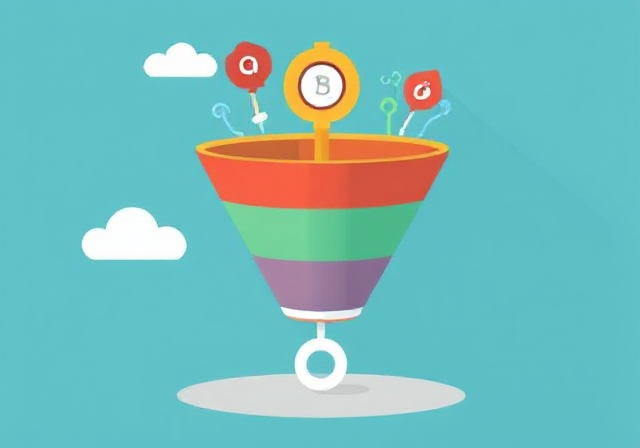A well-optimized marketing funnel is essential for guiding potential customers from initial awareness to final conversion. However, even the most carefully constructed funnels can have weak links that hinder your business’s growth. Identifying and fixing these weak links is crucial for improving conversion rates and maximizing ROI. This article will walk you through the process of diagnosing and addressing weak points in your marketing funnel, helping you build a more effective strategy for customer acquisition.
What is a Marketing Funnel?
Before we dive into identifying weak links, it’s important to understand the marketing funnel concept. A marketing funnel represents the journey a potential customer takes from becoming aware of your brand to making a purchase. It is typically broken down into the following stages:
- Awareness: The customer learns about your brand.
- Interest: The customer shows interest in your products or services.
- Consideration: The customer evaluates whether your offerings meet their needs.
- Decision: The customer is ready to make a purchase.
- Action: The customer converts (makes a purchase, fills out a form, etc.).
Each stage in the funnel requires different marketing tactics and strategies. However, as your funnel matures, it’s not uncommon for certain areas to become less effective. When this happens, conversions can stagnate, and you may lose valuable leads.
Identifying Weak Links in Your Marketing Funnel
A weak link in your marketing funnel can occur at any stage of the customer journey. It’s important to analyze the funnel and pinpoint where leads are dropping off. Here’s how to identify weak links:
1. Analyze Your Data
The first step in identifying weak points in your marketing funnel is to review your analytics. By examining website traffic, conversion rates, and user behavior data, you can determine where leads are exiting the funnel. Key metrics to focus on include:
- Bounce Rate: A high bounce rate on your landing pages can indicate that users are not finding the information they need and are leaving before moving to the next stage.
- Drop-Off Points: If many users abandon your form, checkout, or other key actions, this may point to friction at the decision or action stage.
- Lead Scoring: Evaluate how leads are progressing through the funnel. A significant drop in lead quality as they move closer to conversion suggests a problem with your targeting or nurturing efforts.
By working with a Greensboro digital marketing expert, you can gather in-depth insights into your funnel’s performance and receive advice on how to fix bottlenecks.
2. User Experience (UX) Issues
A major weak link in many funnels is a poor user experience. If your website is hard to navigate, or if there are issues with page load speeds, mobile optimization, or confusing calls to action (CTAs), users are likely to drop off. A seamless, intuitive UX is crucial for guiding prospects smoothly through your funnel.
3. Irrelevant Content
At each stage of the funnel, your content needs to align with the user’s intent. If your content is too broad or fails to address specific pain points, you risk losing the potential lead. For example, if your Brands Ranker blog or landing page does not provide the right value at the awareness stage, or if your offers are not relevant to the customer’s needs at the decision stage, your funnel is compromised.
4. Lack of Clear CTAs
Clear, compelling CTAs (calls to action) are essential to moving prospects from one stage to the next. If your CTAs are vague, buried, or unconvincing, potential customers may not know what action to take, leading to abandoned conversions. Every touchpoint in your funnel should clearly guide the customer toward the next step.
5. Failure to Nurture Leads
If you don’t properly nurture leads through email campaigns, retargeting ads, or follow-up communication, you risk losing prospects who may not be ready to convert immediately. Nurturing involves providing value and building trust until the lead is ready to make a decision.
How to Fix Weak Links in Your Marketing Funnel
Once you’ve identified the weak links in your funnel, the next step is to address them strategically. Here are actionable ways to fix these issues:
1. Optimize Landing Pages and Website Design
A common issue that weakens the marketing funnel is poorly designed landing pages. Optimizing your landing pages for both desktop and mobile users can significantly improve conversions. Ensure that your pages load quickly, have a clear and compelling CTA, and offer value that aligns with the visitor’s stage in the buyer journey.
As a Greensboro digital marketing expert, you can get professional guidance on A/B testing your landing pages to find the most effective design and messaging that resonate with your audience.
2. Create Targeted Content for Each Funnel Stage
Tailor your content to meet the needs of your audience at each funnel stage. For example, at the awareness stage, focus on blog posts or videos that address common problems or offer helpful solutions. At the decision stage, provide case studies, product demos, or testimonials to give users confidence in making a purchase. Providing relevant content at each touchpoint can help nurture leads toward conversion.
3. Improve Lead Qualification and Scoring
Lead scoring helps prioritize high-quality leads by assigning value based on actions such as downloading content or visiting specific pages. Implementing an effective lead scoring system allows your sales team to focus on the most promising prospects, reducing the chances of weak leads wasting time and resources.
4. Enhance CTAs and Offer Incentives
Ensure your CTAs are clear and action-oriented. Use strong language such as “Get Started Now,” “Claim Your Free Trial,” or “Book a Demo.” To further incentivize action, offer time-sensitive discounts, exclusive content, or free resources that push prospects to act quickly.
5. Automate Lead Nurturing
Email automation and retargeting ads are effective ways to nurture leads throughout the funnel. By sending personalized, timely follow-ups, you can stay top-of-mind and continue providing value until the lead is ready to convert. Marketing automation tools can also segment your leads, allowing for more customized communication based on user behavior.
Conclusion
Identifying and fixing weak links in your marketing funnel is essential for improving conversion rates and optimizing your marketing efforts. By using data to analyze drop-off points, improving UX, creating targeted content, and nurturing leads effectively, you can build a more efficient and effective funnel. For businesses like Brands Ranker, working with a Greensboro digital marketing expert can provide the necessary expertise to pinpoint and address weaknesses, ultimately leading to higher sales and better ROI.




